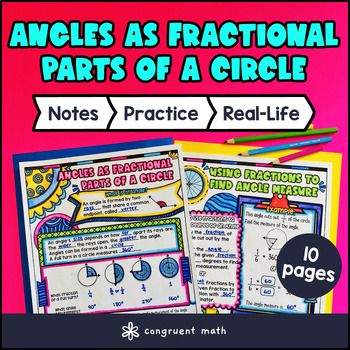Want more ideas and freebies?
Get my free resource library with digital & print activities—plus tips over email.
Join for Free Resources →
$4.25
Ever wondered how to teach angles as fractional parts of a circle in an engaging way to your 4th grade students?
In this lesson plan, students will learn about angle measurement using fractions of a circle and their real-life applications. Through artistic, interactive guided notes, checks for understanding, a color-by-code activity, and a maze worksheet, students will gain a comprehensive grasp of angle measurement in degrees.
The lesson culminates with a real-life example that explores how understanding fractional parts of a circle applies to everyday math situations.

$4.25
After this lesson, students will be able to:
Before this lesson, students should be familiar with:
As a hook, ask students if they have ever noticed the hands of a clock moving and wondered how much of a full turn the minute hand makes as it moves from one number to the next. Refer to the last page of the guided notes for examples of real-life situations where understanding parts of a circle helps, as well as the FAQs below for ideas on engaging students with this question.
Use the first page of the guided notes to introduce the concept of angles as fractional parts of a circle. Walk through the key idea that a circle can be divided into equal slices or parts (fractions), and each slice corresponds to a certain angle measurement in degrees. Explicitly model how a full circle is 360 degrees and how fractional parts such as halves, quarters, and thirds relate to portions of this total 360 degrees. Show visual examples and encourage students to relate fractions to angle sizes using the doodles and graphic organizers on the page. Refer to the FAQ below for guidance on explaining why circles are measured in 360 degrees and how to respond if students ask why fractions are used to find angles.
Use the second page of the guided notes to deepen understanding by working through examples where students identify fractional parts of a circle and convert these to degree measurements. Highlight how multiplying the fraction by 360 gives the angle measure, and provide clear steps in the guided notes for students to follow. Emphasize encouraging students to check their work with the visuals and doodles, reinforcing the connection between the fraction and the circular arc it represents. Refer to the FAQ below for suggestions on supporting students who struggle with the fraction-to-degree conversion or need help visualizing the parts of a circle.
Based on student responses and the checks for understanding embedded within the guided notes, reteach any concepts where students demonstrate confusion, such as the idea of fractions representing parts of a circle or how to calculate angle measures from these fractions. If your class includes a wide range of proficiency levels, consider pulling out students who need additional support for targeted reteaching, while having more advanced students begin exploring the practice exercises or helping peers with explanations.
Have students practice angles as fractional parts of a circle using the color by code and maze activity. Walk around to answer student questions.
Fast finishers can dive into the problem sets for extra practice. You can assign it as homework for the remainder of the class.
Bring the class back together, and introduce the concept of how understanding angles as fractional parts of a circle applies to real-world situations such as reading clocks, navigating with compasses, and dividing pizza slices fairly. Use examples like how a clock’s hands create angles corresponding to fractions of a circle or how architects and engineers use angle measurements to design structures. Refer to the FAQ for more ideas on how to teach it!
If you’re looking for digital practice for angles as fractional parts of a circle, try my Pixel Art activities in Google Sheets. Every answer is automatically checked, and correct answers unlock parts of a mystery picture. It’s incredibly fun, and a powerful tool for differentiation.
Here’s 1 activity to explore:
An angle as a fractional part of a circle represents how much of the entire 360 degrees of the circle the angle covers. It shows the angle as a fraction or portion of the full circle.
To find the degree measure of an angle from a fraction of a circle, multiply the fraction by 360 degrees, since a full circle measures 360 degrees.
The relationship is that fractions represent parts of a full circle, and degrees measure those parts. For example:
We use 360 degrees in a circle because historically it relates to the approximate number of days in a year and the circle’s geometric properties. It also divides evenly into many fractions, making calculations easier.
Visual models show a circle divided into equal parts, helping students see fractions as sections of the circle. This makes the connection between fraction size and angle measurement clearer.
Learning angles as fractional parts helps build foundational skills in geometry and measurement. It improves understanding of fractions, decimals, and the concept of a whole in real-world math applications.
Guided notes and doodles engage students through interactive and visual learning methods. They help with retention by allowing students to actively participate and relate concepts through colors and drawings.
Yes, angle measurement problems relate to real life in activities like reading clocks, design, navigation, and sports. Understanding angles helps in practical problem solving and spatial awareness.
Get my free resource library with digital & print activities—plus tips over email.
Join for Free Resources →